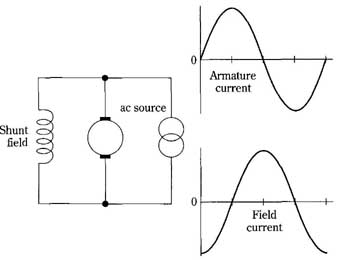AMAZON multi-meters discounts AMAZON oscilloscope discounts
.An interesting question is why we don’t see DC shunt motors operated as AC machines? This is a natural question in light of the fact that the DC series motor (or optimized versions thereof) can yield very satisfactory performance when powered from an AC source. It would appear that the same logic would pertain to both machines—the field and armature undergo simultaneous polarity reversals and the resultant torque should be unidirectional with both machines. That is, both should develop net motor action on AC.
If you encounter this dilemma for the first time you might suspect a fallacy in the logic as worded. The fallacy has to do with the word, “simultaneous”. It might appear that relativity theory is being brought into the discussion. However, the use of the word here has a simple implication. Although the same voltage is simultaneously impressed across both armature and field terminals, their currents don’t both simultaneously rise and fall with the applied AC voltage. Because of the large inductance of the shunt field winding, the field current is out of phase with the armature cur rent. Unfortunately, this phase difference amounts to nearly 90° in practical shunt motors. This quadrature lag in the phase of the field current is shown in FIG. 29.

FIG. 29 Unlike the series motor, the DC shunt motor is not suited for
AC operation. The high inductance of the shunt field causes armature
and shunt field cur rents to be very much out of phase. There is little
opportunity for torque-producing interaction between their magnetic fields.
Inasmuch as the magnetic field of the shunt field winding is produced by its ampere turns, it follows that a lagging current is accompanied by a time-delayed magnetic field. This tells us that when the magnetic field of the armature is maximum, the magnetic field from the field winding is at, or near, minimum. The converse relationship is also true for these magnetic fields. Inasmuch as motor action depends on the interaction between these two magnetic fields, it’s clear that the quadrature phase relationship allows little opportunity for such interaction. Therefore, the AC powered shunt motor either does not run at all, or develops impractically small torque. Contrast this situation to that of the series motor where the common cur rent through the field winding and the armature allows interaction between simultaneously occurring magnetic fields.
While on the subject, it should be obvious why a permanent-magnet DC motor cannot run on ac. Here, to be sure, there is strong interaction between the motor fields. The trouble is that this interaction is at one instant clockwise, then counter clockwise at the next instant, and so on. The net result is that the motor is free to vibrate, but not to develop torque in either direction. And unlike certain single-phase AC motors, no amount of spin of the shaft can provoke the permanent-magnet DC motor to operate on AC power.